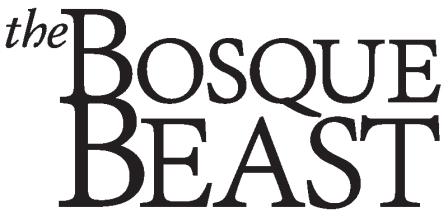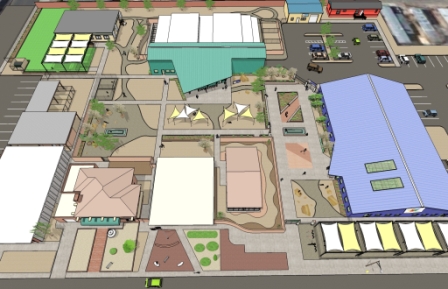
Albuquerque’s top animal charity makes a huge leap toward no-kill
If you remember what Animal Humane used to be like, it’s nothing short of miracle how the organization has jumped to the head of the rescue scene since Peggy Weigle became executive director six years ago.
“Nobody cared,” Weigle recalls of the organization she unexpectedly joined in 2006. “Everything was in bad repair. Staff morale was low, the HVAC (heating/ cooling) system was broken. We didn’t even thank people who donated less than $500! We spent the first year just apologizing to people.”
Plan for renovated campus
Now broadcasting a cheerful presence in neighborhoods across the city, Animal Humane has become the first place people think of to adopt a homeless pet, offering ongoing support to pet owners from vaccinations to obedience classes. More to the point, Animal Humane is closing in on the goal of adopting out every animal it takes in — what some refer to as the holy grail of “no kill” — which is no mean feat for an organization that accepts 5,300 animals a year.
To help put that goal within reach, Animal Humane has broken ground on an ambitious $5 million capital renovation project that will replace its hodgepodge of buildings in southeast Albuquerque with the state of the art in shelter design — changes that Weigle says have been proven to get animals adopted.
“It has been the vision of Animal Humane for several decades,” she says of the 47-year-old nonprofit. “It grows out of working toward saving more lives.”
“Saving more lives” is a theme heard often in Weigle’s many presentations to groups and donors across the country. It is the first among seven outcomes promised by the 20-month project that broke ground in August.
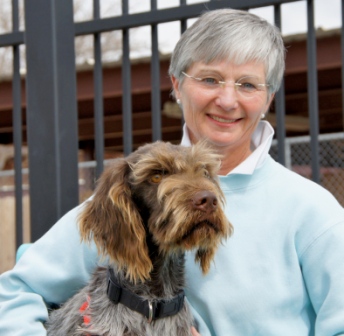
Since she first offered to help out in 2006 and was instead handed a job description by the retiring director, Weigle has added $1.5 million in programs and facilities toward the life-saving goal. These include Animal Humane’s satellite adoption clinics on Montgomery Avenue and Corrales Road, which adopt out about 1,000 animals a year; the state’s first low-income veterinary clinic, which treats 3,000 patients a year; and a cat facility modeled on the iconic Best Friends Animal Sanctuary in Utah. Humane education for children has been added, along with a trap/neuter feral cat program that has reduced kitten intakes by 25 percent. Staff has doubled to 85; euthanasia rates have fallen 65 percent under her tenure.
Weigle’s focus now is on that last percentage of animals being euthanized that might be saved. She says an analysis of 2011 data showed that 40 percent of euthanized animals might have been adoptable if the organization had adequate facilities to treat ringworm and reduce stress-related conditions. That’s why quarantine facilities, cleaner and quieter kennels, and an expanded clinic rank high on the list of changes, along with other upgrades that help create a calm, predictable environment from the moment pets arrive.
The warren of buildings and yards that make up the Animal Humane campus in a remote, rundown part of the city has been a source of frustration on this score for years. Weigle recalls shopping for alternatives as soon as she started her job. But after a career running nonprofits and high-tech companies, she recognized that an organization with no track record on capital projects would find it tough to raise $8 million or more for a new campus.
Six years later, with fundraising successes like the $1 million low-income vet clinic and the $100,000 Robbie Jones Memorial Cat House under its belt, a $5 million expansion appears well within Animal Humane’s sights. But Weigle has since rethought priorities and decided to upgrade the current facility, in effect improving the neighborhood rather than abandoning it.
Renovation plans include such neighborhood upgrades as a landscaped central park, a separate park along Virginia Street offering trees and seating, and an off-street loading area for Project Fetch, which takes hundreds of animals each year from outlying rural communities that would otherwise be euthanized.
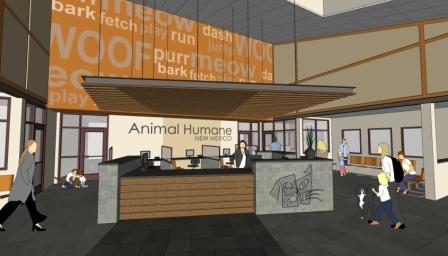
Planned in five phases, the project’s first and most important undertaking is a $2.75 million adoption and administration building featuring an appealing, hospital-like lobby. Shelters with such lobbies report a 28 to 40 percent increase in adoptions, Weigle says. Instead of cages, dogs will be met in 25 “real-life rooms” with individual ventilation and drainage systems. A new multi-use education room should double current outreach to more than 3,500 people a year.
A completely separate admissions building will minimize encounters between animals that are losing and gaining homes. A new cattery with state-of-theart “condos” will be linked to the existing cat house, so animals don’t have to be moved back and forth across campus.
Designed by the specialty firm Animal Arts in Boulder, Colorado, the master plan relies for some $1.27 million in funding on naming opportunities for donors, who can assign their legacy to everything from the adoption lobby to one of the real-life rooms (half of which are spoken for at $15,000 each).
A much larger expansion was completed by the Santa Fe Humane Society and Animal Shelter in 2005, with nearly all of the $10.2 million raised from public donations over a period of several years. Animal Humane is much closer to its goal, starting with $2 million from investments and another $1.7 million from existing donors, effectively funding the first two phases of construction.
However, “that last million will be the hardest to raise,” says Weigle, and will depend on tapping every last animal-lover who will part with $5 to save more lives. Large donors so far have proved “truly inspired” by that goal, says Weigle, and “all agree that facilities are where that starts.”
The Santa Fe shelter has undoubtedly improved its ability to save lives, says public information officer Ben Swan. Its live-release rate is now at 90 percent — which equals Animal Humane’s record, even though Santa Fe serves as the city’s “open-admission” shelter, accepting about 6,500 animals a year. Very few openadmission shelters achieve euthanasia rates below 20 percent, and 10 percent is considered low enough by some standards to merit the politically divisive term of “no kill.” (By comparison, the City of Albuquerque shelters took in 24,200 dogs and cats last year, of which 29 percent were euthanized.)
“We haven’t had to euthanize for space,” says Swan, “and the increase in space also helps reduce stress on animals so they don’t deteriorate while they’re here.” If humane sheltering is the goal, in other words, improved facilities clearly help. And while Weigle will never rest short of perfection, saving more lives is a goal that Project Humane can deliver.
Information at www.projecthumane.org
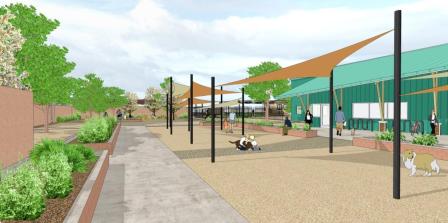
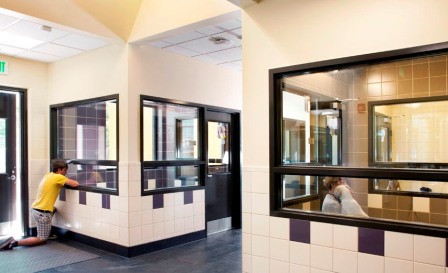
"Real-life" rooms in a Denver shelter. Right: A plan for dog runs where potential adopters can meet their future family members.
"Real-life rooms in A
